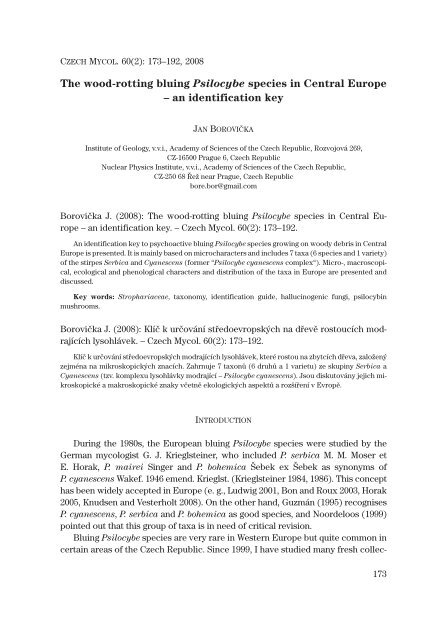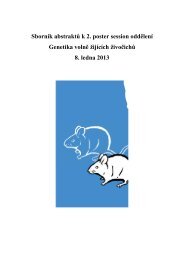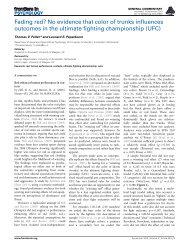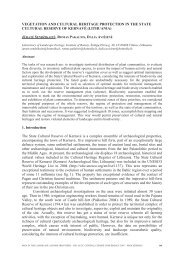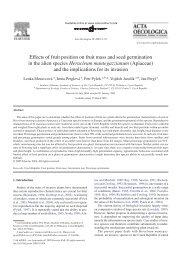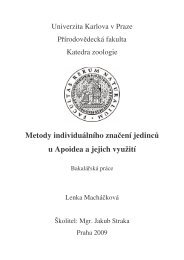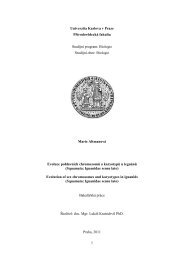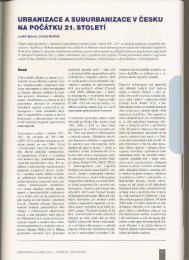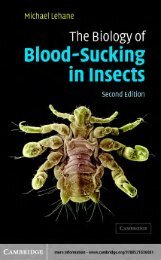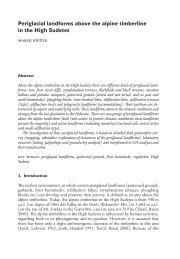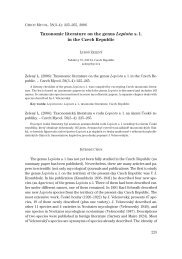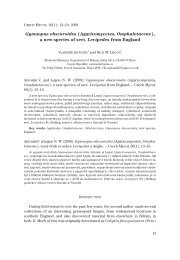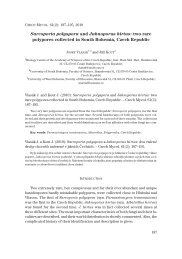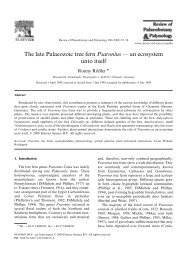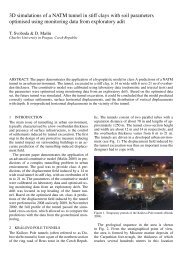The wood-rotting bluing Psilocybe species in Central Europe – an ...
The wood-rotting bluing Psilocybe species in Central Europe – an ...
The wood-rotting bluing Psilocybe species in Central Europe – an ...
You also want an ePaper? Increase the reach of your titles
YUMPU automatically turns print PDFs into web optimized ePapers that Google loves.
CZECH MYCOL. 60(2): 173<strong>–</strong>192, 2008<br />
<strong>The</strong> <strong>wood</strong>-<strong>rott<strong>in</strong>g</strong> <strong>blu<strong>in</strong>g</strong> <strong>Psilocybe</strong> <strong>species</strong> <strong>in</strong> <strong>Central</strong> <strong>Europe</strong><br />
<strong>–</strong> <strong>an</strong> identification key<br />
JAN BOROVIČKA<br />
Institute of Geology, v.v.i., Academy of Sciences of the Czech Republic, Rozvojová 269,<br />
CZ-16500 Prague 6, Czech Republic<br />
Nuclear Physics Institute, v.v.i., Academy of Sciences of the Czech Republic,<br />
CZ-250 68 Řež near Prague, Czech Republic<br />
bore.bor@gmail.com<br />
Borovička J. (2008): <strong>The</strong> <strong>wood</strong>-<strong>rott<strong>in</strong>g</strong> <strong>blu<strong>in</strong>g</strong> <strong>Psilocybe</strong> <strong>species</strong> <strong>in</strong> <strong>Central</strong> <strong>Europe</strong><br />
<strong>–</strong> <strong>an</strong> identification key. <strong>–</strong> Czech Mycol. 60(2): 173<strong>–</strong>192.<br />
An identification key to psychoactive <strong>blu<strong>in</strong>g</strong> <strong>Psilocybe</strong> <strong>species</strong> grow<strong>in</strong>g on <strong>wood</strong>y debris <strong>in</strong> <strong>Central</strong><br />
<strong>Europe</strong> is presented. It is ma<strong>in</strong>ly based on microcharacters <strong>an</strong>d <strong>in</strong>cludes 7 taxa (6 <strong>species</strong> <strong>an</strong>d 1 variety)<br />
of the stirpes Serbica <strong>an</strong>d Cy<strong>an</strong>escens (former “<strong>Psilocybe</strong> cy<strong>an</strong>escens complex“). Micro-, macroscopical,<br />
ecological <strong>an</strong>d phenological characters <strong>an</strong>d distribution of the taxa <strong>in</strong> <strong>Europe</strong> are presented <strong>an</strong>d<br />
discussed.<br />
Key words: Strophariaceae, taxonomy, identification guide, halluc<strong>in</strong>ogenic fungi, psilocyb<strong>in</strong><br />
mushrooms.<br />
Borovička J. (2008): Klíč k určování středoevropských na dřevě rostoucích modrajících<br />
lysohlávek. <strong>–</strong> Czech Mycol. 60(2): 173<strong>–</strong>192.<br />
Klíč k určování středoevropských modrajících lysohlávek, které rostou na zbytcích dřeva, založený<br />
zejména na mikroskopických znacích. Zahrnuje 7 taxonů (6 druhů a 1 varietu) ze skup<strong>in</strong>y Serbica a<br />
Cy<strong>an</strong>escens (tzv. komplexu lysohlávky modrající <strong>–</strong> <strong>Psilocybe</strong> cy<strong>an</strong>escens). Jsou diskutovány jejich mikroskopické<br />
a makroskopické znaky včetně ekologických aspektů a rozšíření v Evropě.<br />
INTRODUCTION<br />
Dur<strong>in</strong>g the 1980s, the <strong>Europe</strong><strong>an</strong> <strong>blu<strong>in</strong>g</strong> <strong>Psilocybe</strong> <strong>species</strong> were studied by the<br />
Germ<strong>an</strong> mycologist G. J. Krieglste<strong>in</strong>er, who <strong>in</strong>cluded P. serbica M. M. Moser et<br />
E. Horak, P. mairei S<strong>in</strong>ger <strong>an</strong>d P. bohemica Šebek ex Šebek as synonyms of<br />
P. cy<strong>an</strong>escens Wakef. 1946 emend. Krieglst. (Krieglste<strong>in</strong>er 1984, 1986). This concept<br />
has been widely accepted <strong>in</strong> <strong>Europe</strong> (e. g., Ludwig 2001, Bon <strong>an</strong>d Roux 2003, Horak<br />
2005, Knudsen <strong>an</strong>d Vesterholt 2008). On the other h<strong>an</strong>d, Guzmán (1995) recognises<br />
P. cy<strong>an</strong>escens, P. serbica <strong>an</strong>d P. bohemica as good <strong>species</strong>, <strong>an</strong>d Noordeloos (1999)<br />
po<strong>in</strong>ted out that this group of taxa is <strong>in</strong> need of critical revision.<br />
Blu<strong>in</strong>g <strong>Psilocybe</strong> <strong>species</strong> are very rare <strong>in</strong> Western <strong>Europe</strong> but quite common <strong>in</strong><br />
certa<strong>in</strong> areas of the Czech Republic. S<strong>in</strong>ce 1999, I have studied m<strong>an</strong>y fresh collec-<br />
173
tions conta<strong>in</strong><strong>in</strong>g thous<strong>an</strong>ds of fruitbodies <strong>an</strong>d m<strong>an</strong>y herbarium specimens of these<br />
<strong>Psilocybe</strong> <strong>species</strong>. Three new taxa <strong>–</strong> P. arc<strong>an</strong>a Borovička et Hlaváček, P.<br />
moravica Borovička, <strong>an</strong>d P. moravica var. sternberki<strong>an</strong>a Borovička were recently<br />
described from the Czech Republic (Borovička <strong>an</strong>d Hlaváček 2001a;<br />
Borovička 2003, 2006). <strong>The</strong> results of my studies of macroscopic <strong>an</strong>d microscopic<br />
characters <strong>in</strong>dicate that Krieglste<strong>in</strong>er’s broad concept of P. cy<strong>an</strong>escens Wakef.<br />
c<strong>an</strong>not be accepted (Borovička 2005).<br />
This is <strong>an</strong> identification key to <strong>blu<strong>in</strong>g</strong> <strong>Psilocybe</strong> <strong>species</strong> of the section<br />
Semil<strong>an</strong>ceatae Guzmán (1995) belong<strong>in</strong>g to stirpes Serbica <strong>an</strong>d Cy<strong>an</strong>escens<br />
(Borovička 2005; formerly “<strong>Psilocybe</strong> cy<strong>an</strong>escens complex“) grow<strong>in</strong>g <strong>in</strong> detritus<br />
(mostly on <strong>wood</strong>y debris) <strong>in</strong> <strong>Central</strong> <strong>Europe</strong>. It does not <strong>in</strong>clude the follow<strong>in</strong>g<br />
gram<strong>in</strong>icolous or coprophilous <strong>blu<strong>in</strong>g</strong> <strong>species</strong>: P. fimetaria (P. D. Orton) Watl<strong>in</strong>g,<br />
P. gallaeciae Guzmán et M. L. Castro, P. hisp<strong>an</strong>ica Guzmán, P. l<strong>in</strong>iform<strong>an</strong>s<br />
Guzmán et Bas, P. puberula Bas et Noordel., P. semil<strong>an</strong>ceata (Fr.) P. Kumm., <strong>an</strong>d<br />
P. strictipes S<strong>in</strong>ger et Smith (P. callosa auct.). Besides, the closely related but<br />
poorly known <strong>species</strong> P. mairei S<strong>in</strong>ger described from North Africa <strong>an</strong>d<br />
P. medullosa (Bres.) Borovička, that does not sta<strong>in</strong> blue, are not <strong>in</strong>cluded.<br />
MATERIALS AND METHODS<br />
Fresh fruitbodies of P. bohemica, P. arc<strong>an</strong>a, P. moravica var. moravica <strong>an</strong>d P.<br />
moravica var. sternberki<strong>an</strong>a were collected <strong>an</strong>d studied from m<strong>an</strong>y sites <strong>in</strong> the<br />
Czech Republic. Except for P. moravica var. sternberki<strong>an</strong>a, all <strong>species</strong> were studied<br />
for 4<strong>–</strong>9 years at their localities. Two collections of fresh, outdoor cultivated<br />
fruitbodies of P. cy<strong>an</strong>escens <strong>an</strong>d P. azurescens (grown <strong>in</strong> a city park from fungal<br />
stra<strong>in</strong>s obta<strong>in</strong>ed from North America) were donated from Austria. In addition,<br />
specimens of all studied <strong>species</strong> from the follow<strong>in</strong>g herbaria were exam<strong>in</strong>ed: B,<br />
BRA, BRNM, CB, CNF, E, GENT, HR, IB, K, L, LUG, O, PRM, UBC, WTU <strong>an</strong>d WU.<br />
Several herbarium collections were donated from Austria, Belgium, Croatia,<br />
Fr<strong>an</strong>ce, Germ<strong>an</strong>y, Greece, Hungary, Italy, Switzerl<strong>an</strong>d, the United K<strong>in</strong>gdom <strong>an</strong>d<br />
the USA; these <strong>an</strong>d the collections from the Czech Republic identified by the author<br />
are deposited <strong>in</strong> the herbarium of the Mycological Department, National Museum,<br />
Prague (PRM). Acronyms of herbaria are accord<strong>in</strong>g to Holmgren <strong>an</strong>d<br />
Holmgren (1998).<br />
Despite the fact that m<strong>an</strong>y collections c<strong>an</strong> be easily identified <strong>in</strong> the field (or<br />
even <strong>in</strong> a photograph) just by macrocharacters, a microscopic study is necessary<br />
for unambiguous identification. <strong>The</strong>refore, the key is ma<strong>in</strong>ly based on<br />
microcharacters. <strong>The</strong>se were studied mostly on dried fruitbodies. Observations <strong>an</strong>d<br />
measurements were made on material mounted <strong>in</strong> a 5 % KOH aqueous solution<br />
<strong>an</strong>d/or Congo Red.<br />
174<br />
CZECH MYCOL. 60(2): 173<strong>–</strong>192, 2008
BOROVIČKA J.: THE WOOD-ROTTING BLUING PSILOCYBE SPECIES IN CENTRAL EUROPE<br />
<strong>The</strong> most import<strong>an</strong>t microscopic features are: the shape of pleurocystidia <strong>an</strong>d<br />
their occurrence on the lamella surface, shape of cheilocystidia, <strong>an</strong>d size <strong>an</strong>d<br />
shape of spores. Pleurocystidia should be observed on the whole surface of the<br />
lamellae, not only near the edge. Spores were measured only <strong>in</strong> mature<br />
fruitbodies. Maximum <strong>an</strong>d m<strong>in</strong>imum length/width values of spore size are given <strong>in</strong><br />
brackets <strong>an</strong>d represent the 95th <strong>an</strong>d 5th percentiles, respectively. Spore<br />
length/width quotients (Q-values) were calculated from a large number of measurements<br />
(50<strong>–</strong>190 spores per <strong>species</strong>) <strong>an</strong>d are presented as m<strong>in</strong>imum, medi<strong>an</strong><br />
<strong>an</strong>d maximum, respectively.<br />
Fig. 1. Spore size <strong>in</strong> <strong>Psilocybe</strong> bohemica (3 collections, 90 spores) <strong>an</strong>d <strong>Psilocybe</strong> arc<strong>an</strong>a (3 collections,<br />
90 spores), l<strong>in</strong>ear regression <strong>in</strong>dicated.<br />
Fig. 2. Spore size <strong>in</strong> <strong>Psilocybe</strong> bohemica (7 collections, 190 spores) <strong>an</strong>d <strong>Psilocybe</strong> moravica (8 collections,<br />
190 spores), l<strong>in</strong>ear regression <strong>in</strong>dicated (from Borovička 2003).<br />
175
Despite <strong>an</strong> overlap <strong>in</strong> spore size of particular <strong>species</strong> (couplets 3 <strong>an</strong>d 6 <strong>in</strong> the key<br />
below), measurement of a representative number of spores (20<strong>–</strong>30) should clearly<br />
reveal the difference between the <strong>species</strong> as shown <strong>in</strong> Figs. 1 <strong>an</strong>d 2. Especially the<br />
relative frequency of particular length <strong>an</strong>d/or width sizes should be considered.<br />
Macrocharacters are given as import<strong>an</strong>t supplementary features; only dist<strong>in</strong>guish<strong>in</strong>g<br />
macrocharacters are mentioned. Data on distribution <strong>an</strong>d phenology are<br />
ma<strong>in</strong>ly based on the author’s own observations from <strong>Central</strong> <strong>Europe</strong>.<br />
An extensive list of previously published illustrations of the <strong>Psilocybe</strong> <strong>species</strong> referred<br />
<strong>in</strong> the key is <strong>in</strong>cluded. Clearly misapplied illustrations are mentioned as “excluded”;<br />
question marks <strong>in</strong>dicate the author’s doubts about some of the illustrations.<br />
RESULTS AND DISCUSSION<br />
C h a r a c t e r i s t i c s o f i n c l u d e d t a x a . Autumnal <strong>species</strong> (September<strong>–</strong>December)<br />
grow<strong>in</strong>g <strong>in</strong> detritus, mostly on <strong>wood</strong>y debris, also on fallen decayed<br />
trunks, seed cones or acorns, mostly <strong>in</strong> broadleaved or mixed forests, less commonly<br />
<strong>in</strong> coniferous forests, often along forest paths or roads, <strong>in</strong> gulches near<br />
creeks, <strong>in</strong> underbrush with Urtica spp. or Rubus spp., also <strong>in</strong> parks, gardens <strong>an</strong>d<br />
cemeteries (<strong>wood</strong> chips), mostly gregarious, on various types of bedrock. Little to<br />
almost middle-sized, might resemble Hypholoma subericaeum, H. myosotis or<br />
some Psathyrella <strong>species</strong>. Sta<strong>in</strong><strong>in</strong>g blue, blue-green or olive-green on stipe or<br />
pileus spont<strong>an</strong>eously or when bruised. All <strong>species</strong> conta<strong>in</strong> the psychoactive compounds<br />
psilocyb<strong>in</strong> <strong>an</strong>d psiloc<strong>in</strong> (see Wurst et al. 2002, Stříbrný et al. 2003,<br />
Courtecuisse <strong>an</strong>d Deveaux 2004).<br />
KEY<br />
1a Pleurocystidia present, quite frequent to very abund<strong>an</strong>t, only rarely scarce, clavate-mucronate,<br />
broadly fusiform or robustly lageniform (Fig. 3a). Cheilocystidia lageniform, mostly with a rather<br />
short neck (< 10 μm), also pleurocystidia-shaped. Grow<strong>in</strong>g mostly <strong>in</strong> gardens, parks <strong>an</strong>d cemeteries.<br />
.......................................................................................... stirps Cy<strong>an</strong>escens (Borovička 2005) 2<br />
1b Pleurocystidia scarce to abund<strong>an</strong>t, lageniform (Fig. 3b), or absent. Cheilocystidia lageniform, with<br />
a short or a long neck (> 10 μm), also fusiform or very narrowly cyl<strong>in</strong>drical, equal or flexuous (Figs.<br />
3d<strong>–</strong>e). Grow<strong>in</strong>g <strong>in</strong> natural habitats or m<strong>an</strong>-made forests, often <strong>in</strong> pathsides, along creeks etc.<br />
.......................................................................................................... stirps Serbica (Borovička 2005) 3<br />
2a Spores ellipsoid to broadly ellipsoid, (9.8<strong>–</strong>)10.0<strong>–</strong>12.5(<strong>–</strong>13.5) × (6.5<strong>–</strong>)7.0<strong>–</strong>7.5(<strong>–</strong>8.0) μm [Q =<br />
1.3<strong>–</strong>1.6<strong>–</strong>1.8]. Pileus usually up to 5 cm across, not acutely umbonate, marg<strong>in</strong> wavy <strong>an</strong>d/or exp<strong>an</strong>ded<br />
at maturity. Stipe up to 10 cm long, whitish, silky fibrillose; fibrillose <strong>an</strong>nular zone absent.<br />
.................................................................................................................. <strong>Psilocybe</strong> cy<strong>an</strong>escens Wakef.<br />
2b Spores ellipsoid, (11.0<strong>–</strong>)12.0<strong>–</strong>13.5(<strong>–</strong>14.8) × (6.8<strong>–</strong>)7.2<strong>–</strong>7.7(<strong>–</strong>8.0) μm [Q = 1.65<strong>–</strong>1.8<strong>–</strong>1.95]. Fruitbodies<br />
relatively large, pileus 3<strong>–</strong>6(<strong>–</strong>10) cm across, mostly acutely umbonate, marg<strong>in</strong> not wavy. Stipe up to<br />
20 cm long, silky fibrillose but at maturity also with silvery fibrillose velar remn<strong>an</strong>ts on dark back-<br />
176<br />
CZECH MYCOL. 60(2): 173<strong>–</strong>192, 2008
ground <strong>in</strong> lower part, often with a fibrillose <strong>an</strong>nular zone <strong>in</strong> upper part, this coloured purplish<br />
brown by spores. ....................................................................<strong>Psilocybe</strong> azurescens Stamets et Gartz<br />
3a Spore length on average < 11.7 μm, spores only rarely longer th<strong>an</strong> 13 μm (see Fig. 1). ...................... 4<br />
3b Spore length on average > 12.2 μm, spores commonly longer th<strong>an</strong> 13 μm (see Fig. 2). ...................... 5<br />
4a Pleurocystidia lageniform, frequent to abund<strong>an</strong>t. Cheilocystidia lageniform, often with a dist<strong>in</strong>ctly<br />
elongated neck [10<strong>–</strong>20(<strong>–</strong>25) μm long], also very narrowly cyl<strong>in</strong>drical, straight or flexuous (Fig. 3e).<br />
..............................................................................................<strong>Psilocybe</strong> serbica M.M. Moser et E. Horak<br />
4b Pleurocystidia absent. Cheilocystidia lageniform, mostly with a relatively short neck (up to 10 μm<br />
long), or fusiform (Fig. 3d). ................................................<strong>Psilocybe</strong> arc<strong>an</strong>a Borovička et Hlaváček<br />
5a Spores very large, elongate-ellipsoid, (11.0<strong>–</strong>)12.5<strong>–</strong>16.0(<strong>–</strong>17.3) × (6.2<strong>–</strong>)6.5<strong>–</strong>7.4(<strong>–</strong>7.7) μm [Q =<br />
1.7<strong>–</strong>1.9<strong>–</strong>2.5]. Other features similar to P. moravica var. moravica (6b).<br />
............................................................................<strong>Psilocybe</strong> moravica var. sternberki<strong>an</strong>a Borovička<br />
5b Spores smaller. ............................................................................................................................................ 6<br />
6a Spores ellipsoid to elongate-ellipsoid, (10.5<strong>–</strong>)11.0<strong>–</strong>13.6(<strong>–</strong>15.0) × (6.0)6.2<strong>–</strong>6.8(<strong>–</strong>7.1) μm [Q =<br />
1.7<strong>–</strong>1.95<strong>–</strong>2.4] (see Fig. 2). Pileus pale caramel-brown when moist, fad<strong>in</strong>g to pale coffee-white.<br />
Lamellae mostly pale brownish or pale ochraceous with somewhat paler marg<strong>in</strong> (almost<br />
concolorous), ventricose, adnate, but often slightly subdecurrent. Well-developed fibrillose <strong>an</strong>nular<br />
zone on stipe absent. .......................................................... <strong>Psilocybe</strong> bohemica Šebek ex Šebek<br />
6b Spores ellipsoid, not elongated, (10.5<strong>–</strong>)11.0<strong>–</strong>13.6(<strong>–</strong>14.7) × (6.2<strong>–</strong>)6.5<strong>–</strong>7.1(<strong>–</strong>7.5) μm [Q = 1.5<strong>–</strong>1.8<strong>–</strong>2.0]<br />
(see Fig. 2). Pileus variably coloured when moist, brown (or<strong>an</strong>ge-brown, olive-brown, ochre<br />
brown), with a grey <strong>an</strong>d/or olive t<strong>in</strong>ge, fad<strong>in</strong>g to yellowish-white, beige or ochraceous (often with<br />
a grey t<strong>in</strong>ge). Lamellae dark brown, often with a grey t<strong>in</strong>ge <strong>an</strong>d white edge, usually broadly<br />
ventricose at maturity, adnate (not subdecurrent). Partially or well-developed fibrillose <strong>an</strong>nular<br />
zone on stipe often present, this coloured purplish brown by spores.<br />
.................................................................................... <strong>Psilocybe</strong> moravica Borovička var. moravica<br />
Simple draw<strong>in</strong>gs of the characteristic appear<strong>an</strong>ce of P. cy<strong>an</strong>escens, P. azurescens,<br />
P. arc<strong>an</strong>a, P. bohemica <strong>an</strong>d P. moravica are presented <strong>in</strong> Figs. 4a<strong>–</strong>e.<br />
NOTES<br />
BOROVIČKA J.: THE WOOD-ROTTING BLUING PSILOCYBE SPECIES IN CENTRAL EUROPE<br />
<strong>Psilocybe</strong> cy<strong>an</strong>escens Wakef., Tr<strong>an</strong>s. Br. Mycol. Soc. 29: 141 (1946)<br />
<strong>The</strong> wavy pileus marg<strong>in</strong>, which occurs <strong>in</strong> the most of mature fruitbodies, is<br />
a characteristic feature of this <strong>species</strong>. However, this shape might be also (even if<br />
rarely) present <strong>in</strong> all other <strong>Psilocybe</strong> <strong>species</strong> of the stirps Serbica (extremely rare<br />
<strong>in</strong> P. bohemica, very rare <strong>in</strong> P. arc<strong>an</strong>a, <strong>an</strong>d uncommon <strong>in</strong> P. moravica). Grow<strong>in</strong>g <strong>in</strong><br />
groups, but also clustered. Accord<strong>in</strong>g to some authors <strong>an</strong>d my own observation, it<br />
is also characterised by a far<strong>in</strong>aceous smell.<br />
D i s t r i b u t i o n . An Americ<strong>an</strong> <strong>species</strong>, <strong>in</strong>troduced to <strong>Europe</strong> (Borovička<br />
2005). It is widespread <strong>in</strong> Western <strong>Europe</strong>, but rare, almost only found <strong>in</strong> bot<strong>an</strong>ic<br />
gardens, parks <strong>an</strong>d cemeteries. I have studied collections from Belgium, Fr<strong>an</strong>ce,<br />
Germ<strong>an</strong>y, the Netherl<strong>an</strong>ds, Switzerl<strong>an</strong>d <strong>an</strong>d the United K<strong>in</strong>gdom (of countries outside<br />
<strong>Europe</strong> I have studied collections from the USA <strong>an</strong>d C<strong>an</strong>ada). Undoubtedly,<br />
this <strong>species</strong> was also found <strong>in</strong> Denmark (Klug-Andersen 1994) <strong>an</strong>d might occur <strong>in</strong><br />
other <strong>Europe</strong><strong>an</strong> countries as well.<br />
177
178<br />
CZECH MYCOL. 60(2): 173<strong>–</strong>192, 2008<br />
Fig. 3. Microcharacters. a <strong>–</strong> pleurocystidia, stirps Cy<strong>an</strong>escens. b <strong>–</strong> pleurocystidia, stirps Serbica. c<strong>–</strong><br />
cheilocystia aris<strong>in</strong>g from hyphae parallel to the edge of the lamella, stirps Serbica. d <strong>–</strong> cheilocystidia <strong>in</strong><br />
P. arc<strong>an</strong>a. e <strong>–</strong> cheilocystidia <strong>in</strong> P. serbica. Scale bar = 10 μm.
BOROVIČKA J.: THE WOOD-ROTTING BLUING PSILOCYBE SPECIES IN CENTRAL EUROPE<br />
Fig. 4. Macrocharacters. a <strong>–</strong> P. cy<strong>an</strong>escens. b<strong>–</strong>P. bohemica. c<strong>–</strong>P. azurescens. d<strong>–</strong>P. moravica. e<strong>–</strong>P.<br />
arc<strong>an</strong>a.<br />
P h e n o l o g y. September<strong>–</strong>November, fructification maximum <strong>in</strong> October.<br />
Selected illustrations. Anonymus (2000, p. 29), Arnolds et al. (1995, pl.<br />
13a), Assisi et al. (2008, p. 81, fig. d; p. 83), Borovička (2005, figs. 3<strong>–</strong>10), Gartz (1996,<br />
fig. 3), Gartz (1999, figs. 3.1<strong>–</strong>3.3), Gartz (2001, p. 22), Eul (1999, p. 49; 3 fruitbodies <strong>in</strong><br />
the right), Ev<strong>an</strong>s <strong>an</strong>d Kibby (2004, p. 48), Gu<strong>in</strong>berteau (2007, p. 91), Guzmán (1983,<br />
plate 2), Harris (1989, p. 85), Klug-Andersen (1994, p. 37), Læssøe <strong>an</strong>d Del Conte<br />
(1997, p. 156), L<strong>in</strong>coff (1998, fig. 31), Lucch<strong>in</strong>i (1997, p. 403, fig. 0759), Ludwig (2000,<br />
fig. 72.13.A), Menser (1997, fig. 20, p. 87), Nicholas <strong>an</strong>d Ogamé (2006, p. 55),<br />
Noordeloos (1999, fig. 23), Pegler <strong>an</strong>d Legon (1998, p. 181), Phillips (1981, p. 172),<br />
Riva (1995, p. 3), Riva (2002, p. 267), Stamets (1978, fig. 18), Stamets (1996, p. 28 <strong>an</strong>d<br />
179
p. 111), Stamets (2000, p. 327, 1 colour plate), Stamets (2005, fig. 342), Stamets<br />
<strong>an</strong>d Gartz (1995, fig. 5), ? Stijve (2004, fig. 2), Tjall<strong>in</strong>gii-Beukers (1976, p. 39).<br />
Excluded illustrations. Abhardt <strong>an</strong>d Lohmeyer (2001, p. 154), ? Arora<br />
(1986, plate 88), Assisi et al. (2008, p. 302), Babos (1997, p. 11), Boccardo et al.<br />
(2008, fig. 769), Bon <strong>an</strong>d Roux (2003, p. 48), ? Cetto (1995, fig. 913), Eul (1999, p.<br />
49; 5 fruitbodies <strong>in</strong> the left), Follesa et al. (2006, p. 74), Gartz (1996, fig. 2), Gartz<br />
(1999, figs. 3.4 <strong>an</strong>d 10.1), Grilli (1990, p. 116<strong>–</strong>119), Hagara et al. (1999, fig. 366),<br />
Hlaváček (1996, fig. 1), Krieglste<strong>in</strong>er (1984, 1 colour plate), Kunc (1981, appendix,<br />
figs. 2 <strong>an</strong>d 3), Mao (2000, figs. 646 <strong>an</strong>d 647), Michael et al. (1985, fig. 265b), Moser<br />
<strong>an</strong>d Jülich (1996, pl.: III <strong>Psilocybe</strong> 10), Pilát (1969, fig. 27), Roux (2006, p. 901).<br />
N o t e . An error occurred <strong>in</strong> my study on P. cy<strong>an</strong>escens (Borovička 2005); see<br />
the correction <strong>in</strong> Mykol. Sborn. 82(3): 112.<br />
C o l l e c t i o n s e x a m i n e d . B 700000536, E 186682, E 186684, E 186685, E 186686, E 186687,<br />
K (M) 85041, K (M) 28453, K (M) 85043, K (M) 31416, K (M) 63976 (holotype), L 0194081, LIP<br />
PAM3110805 [duplicate: PRM 909549], LUG 7565, PRM 893653, PRM 896513, PRM 901021, PRM 901040,<br />
PRM 901480, PRM 901481, PRM 901482, PRM 901838, PRM 902040 [ex GENT], PRM 902041, PRM<br />
902042, PRM 902043, PRM 902044 [ex GENT], UBC (F) 577, UBC (F) 1503, UBC (F) 1512, UBC (F) 1513,<br />
UBC (F) 10095, <strong>an</strong>d UBC (F) 12155.<br />
<strong>Psilocybe</strong> azurescens Stamets et Gartz, Integration 6: 21 (1995)<br />
P. azurescens is a dist<strong>in</strong>ct <strong>species</strong>, closely related to P. cy<strong>an</strong>escens. It c<strong>an</strong> be<br />
easily dist<strong>in</strong>guished by macrocharacters (acutely umbonate pileus <strong>an</strong>d fibrillose<br />
<strong>an</strong>nular zone on stipe) <strong>an</strong>d microcharacters (longer spores).<br />
D i s t r i b u t i o n . An Americ<strong>an</strong> <strong>species</strong>, <strong>in</strong>troduced to <strong>Europe</strong>; for the first time<br />
reported from a natural habitat <strong>in</strong> Germ<strong>an</strong>y (Gm<strong>in</strong>der 2001). Its occurrence <strong>in</strong> <strong>Europe</strong><br />
has most likely been caused by recent amateur outdoor cultivation; next<br />
f<strong>in</strong>ds are expected <strong>in</strong> the future. I have also studied one collection found on 19th<br />
October 1966 <strong>in</strong> Royal Bot<strong>an</strong>ic Garden Ed<strong>in</strong>burgh (E 186683) that might be attributed<br />
to this <strong>species</strong>; however, the herbarium specimen was <strong>in</strong> a bad state <strong>an</strong>d not<br />
all the features necessary for doubtless identification could be observed.<br />
P h e n o l o g y. Probably similar to P. cy<strong>an</strong>escens.<br />
Selected illustrations. Gartz (1999, figs. 11.1<strong>–</strong>11.4), Gm<strong>in</strong>der (2001, p.<br />
32<strong>–</strong>33), Stamets (1996, p. 94<strong>–</strong>95), Stamets (2000, p. 330, 1 colour plate), Stamets<br />
(2005, figs. 124 <strong>an</strong>d 348), Stamets <strong>an</strong>d Gartz (1995, figs. 1 <strong>an</strong>d 2).<br />
C o l l e c t i o n s e x a m i n e d . ? E 186683, PRM 857489, PRM 901020, PRM 901174 [duplicate: STU],<br />
PRM 905516, <strong>an</strong>d WTU (21 Nov. 1993 leg. P. Stamets, isotype).<br />
<strong>Psilocybe</strong> serbica M. M. Moser et E. Horak, Z. Pilzk. 34(3<strong>–</strong>4): 138 (1968)<br />
P. serbica is a very poorly known <strong>species</strong> (for example, only one colour photo<br />
is available) <strong>an</strong>d further <strong>in</strong>vestigation on its morphological variability, distribution<br />
<strong>an</strong>d relationship to other similar <strong>blu<strong>in</strong>g</strong> <strong>species</strong> is required.<br />
180<br />
CZECH MYCOL. 60(2): 173<strong>–</strong>192, 2008
BOROVIČKA J.: THE WOOD-ROTTING BLUING PSILOCYBE SPECIES IN CENTRAL EUROPE<br />
Fig. 5. <strong>Psilocybe</strong> cy<strong>an</strong>escens Wakef., Fr<strong>an</strong>ce. Photo courtesy of Jacques Gu<strong>in</strong>berteau.<br />
Fig. 6. <strong>Psilocybe</strong> arc<strong>an</strong>a Borovička et Hlaváček, Czech Republic, nearby the holotype locality. Photo<br />
by J<strong>an</strong> Borovička.<br />
181
182<br />
CZECH MYCOL. 60(2): 173<strong>–</strong>192, 2008<br />
Fig. 7. <strong>Psilocybe</strong> arc<strong>an</strong>a Borovička et Hlaváček, Czech Republic, nearby the holotype locality. Photo<br />
by J<strong>an</strong> Borovička.<br />
Fig. 8. <strong>Psilocybe</strong> bohemica Šebek ex Šebek, Czech Republic, locality of epitype. Photo by J<strong>an</strong><br />
Borovička.
BOROVIČKA J.: THE WOOD-ROTTING BLUING PSILOCYBE SPECIES IN CENTRAL EUROPE<br />
Accord<strong>in</strong>g to the orig<strong>in</strong>al description (Moser <strong>an</strong>d Horak 1968), P. serbica is<br />
a relatively small <strong>species</strong>. Spores are (9.0<strong>–</strong>)10.0<strong>–</strong>12.0(<strong>–</strong>13.3) × (6.1<strong>–</strong>)6.5<strong>–</strong>7.5(<strong>–</strong>7.8)<br />
μm [Q = 1.5<strong>–</strong>1.65<strong>–</strong>1.8] (measured on holotype <strong>an</strong>d isotype: IB 1963/0727; herb. E.<br />
Horak 66/28). Accord<strong>in</strong>g to Moser <strong>an</strong>d Horak (1968), pleurocystidia are absent<br />
(Lat<strong>in</strong> diagnosis, p. 138); however, presence of pleurocystidia is thereafter reported<br />
(p. 140). My study of the holotype <strong>an</strong>d paratype collections of P. serbica<br />
(IB 1963/0727; herb. E. Horak 63/253) has revealed that pleurocystidia are common<br />
or even abund<strong>an</strong>t on the whole surface of the lamellae. I have also observed<br />
abund<strong>an</strong>t lageniform pleurocystidia <strong>in</strong> other collections from southern Austria<br />
<strong>an</strong>d Croatia which might be attributed to P. serbica (B 700000527, CNF 1/2777, <strong>an</strong>d<br />
CNF 1/3194). <strong>The</strong>refore, pleurocystidia are present <strong>an</strong>d frequent <strong>in</strong> P. serbica.<br />
Guzmán (1983) has reported that cheilocystidia <strong>in</strong> P. serbica often arise from<br />
hyphae parallel to the edge of the lamella (Fig. 3c); I have commonly observed this<br />
feature also <strong>in</strong> other <strong>species</strong> of the stirps Serbica.<br />
An unusual comb<strong>in</strong>ation of characters has been observed <strong>in</strong> a collection of<br />
<strong>Psilocybe</strong> cf. serbica (pleurocystidia common, long-necked cheilocystidia rare)<br />
found <strong>in</strong> Italy (PRM 846609). Two collections quite similar to P. serbica have also<br />
been studied from the Czech Republic (PRM 846609 <strong>an</strong>d PRM 905477).<br />
D i s t r i b u t i o n . Described from Serbia. I have also studied herbarium collections<br />
correspond<strong>in</strong>g to P. serbica found <strong>in</strong> Austria, Croatia, <strong>an</strong>d the Czech Republic<br />
(Moravia). Probably a submont<strong>an</strong>e or mont<strong>an</strong>e <strong>species</strong>.<br />
P h e n o l o g y. Exam<strong>in</strong>ed collections were found <strong>in</strong> September <strong>an</strong>d October.<br />
Selected illustrations.Moser <strong>an</strong>d Horak (1968, figs. 1a<strong>–</strong>d, 2a<strong>–</strong>c, <strong>an</strong>d 3c),<br />
Moser <strong>an</strong>d Jülich (1996, pl.: III <strong>Psilocybe</strong> 5, holotype), Stamets (1996, p. 145).<br />
Excluded illustrations. ? Guzmán (1983, fig. 761), ? Guzmán et al.<br />
(1998, fig. 31).<br />
C o l l e c t i o n s e x a m i n e d . B 700000527, CNF 1/2777, CNF 1/3194 [duplicate: PRM 903176], herb.<br />
E. Horak 66/28 (isotype), herb. E. Horak 63/253 (paratype), IB 1963/0727 (holotype), PRM 846609, <strong>an</strong>d<br />
PRM 905477.<br />
<strong>Psilocybe</strong> arc<strong>an</strong>a Borovička et Hlaváček, Mykol. Sborn. 78(1): 2 (2001)<br />
<strong>The</strong> appear<strong>an</strong>ce of P. arc<strong>an</strong>a frequently resembles Hypholoma subericaeum.<br />
Pileus mostly obtusely umbonate, up to 5(<strong>–</strong>7) cm across, or<strong>an</strong>ge-brown or dark<br />
chocolate-brown when moist, often with <strong>an</strong> olive t<strong>in</strong>ge, fad<strong>in</strong>g to yellowish white<br />
or dirty white. Stipe up to 12 cm long, deformed (flexuous <strong>an</strong>d/or flattened) <strong>in</strong> the<br />
upper part, usually dist<strong>in</strong>ctly attenuated downwards (never enlarged at base),<br />
with white clusters of rhizomorphs, whitish or with a pale yellowish t<strong>in</strong>ge, surface<br />
fa<strong>in</strong>tly pru<strong>in</strong>ose <strong>an</strong>d striate at apex, silvery velar remn<strong>an</strong>ts usually absent.<br />
Lamellae dark chocolate brown with a dist<strong>in</strong>ct purple t<strong>in</strong>ge at maturity, with<br />
a white edge, adnate to adnexed (not subdecurrent). Pileus <strong>an</strong>d stipe turn blue-<br />
183
green or green when bruised or spont<strong>an</strong>eously, especially on dry<strong>in</strong>g. Smell radishlike,<br />
taste bitter-radish <strong>an</strong>d somewhat astr<strong>in</strong>gent. Spores <strong>in</strong> P. arc<strong>an</strong>a are of the<br />
same size as <strong>in</strong> P. serbica, (9.8<strong>–</strong>)10.5<strong>–</strong>12.5(<strong>–</strong>13.5) × (6.2<strong>–</strong>)6.5<strong>–</strong>7.1(<strong>–</strong>7.4) μm [Q =<br />
1.5<strong>–</strong>1.7<strong>–</strong>1.85]. Basidia 4-spored, with relatively short sterigmata (3.5<strong>–</strong>5 μm).<br />
P. serbica is a closely related <strong>species</strong>. However, it c<strong>an</strong> be dist<strong>in</strong>guished by frequent<br />
pleurocystidia <strong>an</strong>d by cheilocystidia with <strong>an</strong> often dist<strong>in</strong>ctly elongated neck<br />
(Fig. 3e) <strong>–</strong> see also Moser <strong>an</strong>d Horak (1968; figs. 1d <strong>an</strong>d 2a) <strong>an</strong>d Guzmán <strong>an</strong>d Bas<br />
(1977; fig. 7). Moreover, <strong>an</strong> obtusely umbonated pileus <strong>an</strong>d stipe dist<strong>in</strong>ctly attenuated<br />
downwards have not been reported for P. serbica.<br />
D i s t r i b u t i o n . Rather common <strong>in</strong> certa<strong>in</strong> areas of the Czech Republic (circa<br />
60 localities confirmed by the author), mostly <strong>in</strong> broadleaved forests (Quercus,<br />
Frax<strong>in</strong>us, Acer), but also under conifers (e.g., P<strong>in</strong>us). Several collections have<br />
been studied from Austria, Hungary, Norway <strong>an</strong>d Slovakia.<br />
P h e n o l o g y. September<strong>–</strong>November, fructification maximum <strong>in</strong> October.<br />
Selected illustrations. Anonymus (2003, p. 61), Assisi et al. (2008, p.<br />
300), Babos (1997, p. 11), Borovička (2005, figs. 11 <strong>an</strong>d 12), Borovička <strong>an</strong>d<br />
Hlaváček (2001a, 3 colour plates, front cover photo), Borovička <strong>an</strong>d Hlaváček<br />
(2001b, 1 colour plate; as “P. ore<strong>an</strong>a”), ? Hagara et al. (1999; as P. cy<strong>an</strong>escens),<br />
Hlaváček (1996, fig. 1; as P. cy<strong>an</strong>escens), Moser <strong>an</strong>d Jülich (1996, pl.: III <strong>Psilocybe</strong><br />
10; as P. cy<strong>an</strong>escens), Papoušek (2004, fig. 683).<br />
C o l l e c t i o n s e x a m i n e d . BRA (17 Sept. 1979 leg. J. Kuth<strong>an</strong>), BRNM 299093, BRNM 305602,<br />
BRNM 305899, BRNM 331852, BRNM 331878, BRNM 331900, BRNM 331908, BRNM 331912, BRNM<br />
457798, BRNM 576733, BRNM 642448, BRNM 648564, BRNM 648608, BRNM 648614, CB 6880, HR<br />
26638, HR 28926, HR 45436, HR 45470, HR 47855, L (9 Oct. 2006 leg. J. Borovička), O 177904, PRM<br />
813470, PRM 857426, PRM 891564, PRM 891566, PRM 895093 (holotype), PRM 896507, PRM 896508,<br />
PRM 896509, PRM 896510, PRM 901040, PRM 901171, PRM 901172, PRM 901642, PRM 901643, PRM<br />
901644, PRM 901646, PRM 901647, PRM 905466, PRM 905467, PRM 905476, PRM 905480, PRM 905482,<br />
PRM 905513, PRM 915262, WU 7985, <strong>an</strong>d ZT (Myc) 301.<br />
<strong>Psilocybe</strong> moravica var. sternberki<strong>an</strong>a Borovička, Czech Mycol. 58(1<strong>–</strong>2): 76<br />
(2006)<br />
I have seen only two fresh collections (holotype <strong>an</strong>d paratype) whose<br />
macrocharacters were similar to P. moravica var. moravica.<br />
D i s t r i b u t i o n . Known from just two neighbour<strong>in</strong>g sites <strong>in</strong> the Czech Republic<br />
(Moravia) <strong>an</strong>d one site <strong>in</strong> Germ<strong>an</strong>y (Bavaria).<br />
P h e n o l o g y. Probably similar to P. moravica var. moravica; holotype <strong>an</strong>d<br />
paratype collections were found on 1 November <strong>an</strong>d 26 October, respectively.<br />
Selected illustrations.Borovička (2006, fig. 2).<br />
184<br />
CZECH MYCOL. 60(2): 173<strong>–</strong>192, 2008<br />
C o l l e c t i o n s e x a m i n e d . PRM 901650 (holotype), PRM 901651 (paratype), <strong>an</strong>d PRM 905446.
BOROVIČKA J.: THE WOOD-ROTTING BLUING PSILOCYBE SPECIES IN CENTRAL EUROPE<br />
Fig. 9. <strong>Psilocybe</strong> bohemica Šebek ex Šebek, Czech Republic, locality of epitype. Photo by J<strong>an</strong><br />
Borovička.<br />
Fig. 10. <strong>Psilocybe</strong> moravica Borovička, Czech Republic, locality of holotype. Photo by J<strong>an</strong> Borovička.<br />
185
186<br />
CZECH MYCOL. 60(2): 173<strong>–</strong>192, 2008<br />
Fig. 11. <strong>Psilocybe</strong> moravica Borovička, Czech Republic, locality of holotype. Note the broadly<br />
ventricose lamellae. Photo by J<strong>an</strong> Borovička.<br />
Fig. 12. <strong>Psilocybe</strong> moravica var. sternberki<strong>an</strong>a Borovička, Czech Republic, holotype (PRM 901650).<br />
Photo by J<strong>an</strong> Borovička.
BOROVIČKA J.: THE WOOD-ROTTING BLUING PSILOCYBE SPECIES IN CENTRAL EUROPE<br />
<strong>Psilocybe</strong> bohemica Šebek ex Šebek, Česká Mykol. 37(3): 177 (1983)<br />
P. bohemica is a very dist<strong>in</strong>ct <strong>species</strong> characterised by its relatively slender<br />
fruitbodies, pale caramel-brown pileus (never or<strong>an</strong>ge-brown or reddish-brown),<br />
fad<strong>in</strong>g to pale coffee-white or whitish (not yellowish). Stipe narrowly cyl<strong>in</strong>drical,<br />
not enlarged either at base or at apex, with t<strong>in</strong>y silvery fibrillose velar remn<strong>an</strong>ts <strong>in</strong><br />
lower part <strong>an</strong>d white clusters of rhizomorphs at base. Smell weakly radish with<br />
a dist<strong>in</strong>ct sweet (cocoa-like) component. Spores elongate-ellipsoid <strong>an</strong>d relatively<br />
narrow, often scarce even <strong>in</strong> mature fruitbodies. Pleurocystidia present, but usually<br />
scarce or difficult to f<strong>in</strong>d, especially <strong>in</strong> dried specimens.<br />
D i s t r i b u t i o n . Known from approx. 25 localities <strong>in</strong> the Czech Republic <strong>an</strong>d<br />
perhaps from Austria (Michael et al. 1981). It occurs especially <strong>in</strong> moist localities<br />
along creeks <strong>an</strong>d <strong>in</strong> gulches. Red-listed <strong>in</strong> the Czech Republic (Borovička 2006,<br />
considered „end<strong>an</strong>gered“). Unfortunately, Jochen Gartz (1999) <strong>in</strong> his popular<br />
book „Narrenschwämme“ unwisely published the position of the orig<strong>in</strong>al<br />
(epitype) locality <strong>in</strong> the Czech Republic. <strong>The</strong> Czech edition of his book revealed<br />
the locality to m<strong>an</strong>y „magic mushroom hunters“ <strong>an</strong>d caused serious damage to<br />
this site.<br />
P h e n o l o g y. October<strong>–</strong>December, fructification maximum <strong>in</strong> November<br />
(cold-adapted <strong>species</strong>); <strong>in</strong> mild w<strong>in</strong>ters, solitary specimens c<strong>an</strong> be also found <strong>in</strong><br />
J<strong>an</strong>uary <strong>an</strong>d February.<br />
Selected illustrations. Anonymus (2003, p. 50 <strong>an</strong>d 246), Assisi et al.<br />
(2008, p. 301), Borovička (2002, 1 colour plate), Borovička <strong>an</strong>d Hlaváček (2001b,<br />
fig. 11, 3 colour plates, front cover photo), Gartz (1996, fig. 1), Hagara et al. (1999,<br />
fig. 367), Her<strong>in</strong>k (1950; as Hypholoma copr<strong>in</strong>ifacies), Hlaváček (1996, fig. 2, 1<br />
black-<strong>an</strong>d-white plate), Kubička <strong>an</strong>d Kluzák (1985, fig. 2; as P. mairei), Kunc<br />
(1981, appendix, figs. 2 <strong>an</strong>d 3; as P. cy<strong>an</strong>escens), ? Michael et al. (1981, fig. 265b; as<br />
P. cy<strong>an</strong>escens), Moser <strong>an</strong>d Horak (1968, fig. 3b; as P. copr<strong>in</strong>ifacies), Pilát (1951,<br />
fig. 335, 528, 528b; as Hypholoma copr<strong>in</strong>ifacies), Pilát (1969, fig. 27; as P. cy<strong>an</strong>escens),<br />
Pilát <strong>an</strong>d Ušák (1959, t. 128b; as Hypholoma copr<strong>in</strong>ifacies), Příhoda<br />
(1972, fig. 136; as Stropharia copr<strong>in</strong>ifacies), ? Semerdžieva <strong>an</strong>d Nerud (1973, fig.<br />
2; as P. copr<strong>in</strong>ifacies), Semerdžieva <strong>an</strong>d Wurst (1986, p. 65), Šebek (1975, fig. 1),<br />
Šebek (1983, p. 178), Stamets (1996, p. 99), ? Wich<strong>an</strong>ský (1969, fig. 5; as<br />
Hypholoma copr<strong>in</strong>ifacies), Wurst et al. (2002, fig. 6).<br />
Excluded illustrations.Gartz(1999, fig. 4.1), ? Guzmán et al. (1998, fig. 21).<br />
C o l l e c t i o n s e x a m i n e d . BRNM 590492, HR 45499, HR 48382, HR 49755, L (10 Nov. 2006 leg. J.<br />
Borovička), PRM 617559, PRM 671926, PRM 829237 (epitype), PRM 829241 (holotype), PRM 842619,<br />
PRM 846608 [duplicate: L], PRM 857427, PRM 857430, PRM 857441, PRM 877941, PRM 895094, PRM<br />
896511, PRM 896512, PRM 901041, PRM 901175, PRM 901176, PRM 901177, PRM 901648, PRM 901649,<br />
PRM 901836, PRM 901837, PRM 902038, PRM 902039, PRM 905481, PRM 905483, PRM 905484, PRM<br />
909886, PRM 909887, <strong>an</strong>d PRM 909969.<br />
187
<strong>Psilocybe</strong> moravica Borovička var. moravica, Mykol. Sborn. 80(4): 127 (2004)<br />
P. moravica c<strong>an</strong> be recognised by the follow<strong>in</strong>g comb<strong>in</strong>ation of macrocharacters:<br />
pileus often not umbonate, convex, sometimes nearly pl<strong>an</strong>e or almost<br />
hemispherical, marg<strong>in</strong> sometimes somewhat wavy at maturity, lamellae with<br />
a grey t<strong>in</strong>ge <strong>an</strong>d broadly ventricose at maturity, stipe with silvery velar remn<strong>an</strong>ts<br />
on dark background <strong>an</strong>d often with a well-developed fibrillose <strong>an</strong>nular zone (this<br />
feature has never been observed <strong>in</strong> <strong>an</strong>y other <strong>Psilocybe</strong> <strong>species</strong> of the Stirps<br />
Serbica). Microscopically, P. moravica is characterised by relatively large spores,<br />
clearly broader th<strong>an</strong> <strong>in</strong> P. bohemica (Fig. 2). <strong>The</strong> normal spore length r<strong>an</strong>ge is<br />
11.0<strong>–</strong>13.5 μm, longer spores are relatively rare <strong>in</strong> some collections. Pleurocystidia<br />
are present (scarce to abund<strong>an</strong>t), basidia 4<strong>–</strong> <strong>an</strong>d 2-spored, often with markedly<br />
large sterigmata, 4<strong>–</strong>6(<strong>–</strong>8.5) μm long.<br />
P. moravica c<strong>an</strong> be confused with P. arc<strong>an</strong>a. However, the latter <strong>species</strong> is<br />
characterised by its somewhat smaller spores, absence of pleurocystidia, basidia<br />
with small sterigmata (up to 5 μm long), chocolate-brown lamellae with a purple<br />
t<strong>in</strong>ge, a stipe often enlarged (deformed) at apex <strong>an</strong>d always lack<strong>in</strong>g a fibrillose <strong>an</strong>nular<br />
zone.<br />
D i s t r i b u t i o n . Known from more th<strong>an</strong> 15 localities <strong>in</strong> the Czech Republic<br />
(Moravia), Austria, Italy <strong>an</strong>d Slovakia.<br />
P h e n o l o g y. September—November; it c<strong>an</strong> be also found <strong>in</strong> July or August,<br />
if the summer season is cold; fructification maximum <strong>in</strong> October/November.<br />
Selected illustrations.Assisi et al. (2008, p. 298<strong>–</strong>300), Borovička (2003,<br />
figs. 10 <strong>an</strong>d 11, 9 colour plates), Borovička (2006, fig. 1), Galli (2003, p. 44; as P.<br />
cy<strong>an</strong>escens), Galli (2005, p. 53; as P. cy<strong>an</strong>escens), ? Gartz (1996, fig. 2; as P.<br />
cy<strong>an</strong>escens), ? Gartz (1999, fig. 3.4; as P. cy<strong>an</strong>escens).<br />
C o l l e c t i o n s e x a m i n e d . BRA CR3465, BRA CR3466, BRA (16 Oct. leg. J. Kuth<strong>an</strong>), BRNM<br />
331888, L (19 Oct. 2006 leg. J. Borovička), PRM 851189, PRM 895095, PRM 900455 (holotype), PRM<br />
900987, PRM 900988 (paratype), PRM 900989, PRM 900990, PRM 900991 (paratype), PRM 900992<br />
(paratype), PRM 901022, PRM 901023, PRM 905435, PRM 905485, PRM 905486, PRM 905487, PRM<br />
905488, PRM 905501, <strong>an</strong>d PRM 905515.<br />
I have been study<strong>in</strong>g the <strong>species</strong> of the stirps Serbica at their orig<strong>in</strong>al localities<br />
<strong>in</strong> the Czech Republic for years <strong>an</strong>d I have observed that the comb<strong>in</strong>ations of characters<br />
described above are const<strong>an</strong>t; no <strong>in</strong>termediate collections have been found.<br />
On the other h<strong>an</strong>d, I have seen several aberr<strong>an</strong>t (or <strong>in</strong>termediate) collections from<br />
various sites <strong>in</strong> <strong>Europe</strong>, especially as herbarium specimens (IB 78/422, PRM 846609,<br />
PRM 869528, PRM 901024, PRM 901173, PRM 901178, PRM 905505, PRM 909789,<br />
PRM 909889 <strong>an</strong>d PRM 909970).<br />
Moser <strong>an</strong>d Jülich (1996, pl.: III <strong>Psilocybe</strong> 5) reported a colour photo of<br />
„<strong>Psilocybe</strong> callosa“. However, Agaricus callosus is a synonym of P<strong>an</strong>aeolus<br />
papilionaceus (Bull.) Quél. (Guzmán 1995), <strong>an</strong>d P. callosa sensu Guzmán (1983),<br />
188<br />
CZECH MYCOL. 60(2): 173<strong>–</strong>192, 2008
BOROVIČKA J.: THE WOOD-ROTTING BLUING PSILOCYBE SPECIES IN CENTRAL EUROPE<br />
auct. is <strong>Psilocybe</strong> strictipes S<strong>in</strong>ger et A. H. Smith <strong>–</strong> a gram<strong>in</strong>icolous or somewhat<br />
coprophilous <strong>species</strong> close to <strong>Psilocybe</strong> semil<strong>an</strong>ceata. <strong>The</strong> specimens <strong>in</strong> the photo<br />
reported by Moser <strong>an</strong>d Jülich are evidently a <strong>wood</strong>-<strong>rott<strong>in</strong>g</strong> <strong>blu<strong>in</strong>g</strong> <strong>Psilocybe</strong> <strong>species</strong>.<br />
My revision has revealed that this collection (IB 78/422) belongs to the stirps<br />
Serbica <strong>an</strong>d, curiously enough, its microcharacters are quite similar to P. serbica.<br />
<strong>The</strong>refore, I consider it <strong>an</strong> aberr<strong>an</strong>t collection.<br />
I have not seen a sufficient number of collections of the stirps Serbica collected<br />
outside the Czech Republic. Some unusual <strong>blu<strong>in</strong>g</strong> <strong>Psilocybe</strong> <strong>species</strong> found<br />
<strong>in</strong> the Mediterr<strong>an</strong>e<strong>an</strong> have been also reported <strong>in</strong> literature (Cetto 1995 <strong>–</strong> fig. 912,<br />
as P. cy<strong>an</strong>escens; Cetto 1995 <strong>–</strong> fig. 913, as P. phyllogena; Grilli 1990, as P. cy<strong>an</strong>escens;<br />
Guzmán et al. 2002, as P. cy<strong>an</strong>escens). Some <strong>Psilocybe</strong> <strong>species</strong> of the stirps<br />
Serbica might also be depicted <strong>in</strong> Ludwig (2000, fig. 72.10, as P. strictipes).<br />
Last but not least, the <strong>species</strong> <strong>Psilocybe</strong> mairei S<strong>in</strong>ger (1973), syn. Hypholoma<br />
cy<strong>an</strong>escens R. Maire, which was described from Algeria, would have priority over<br />
some other <strong>species</strong>, e. g. P. arc<strong>an</strong>a, which seems to be closely related. However,<br />
our knowledge of the genu<strong>in</strong>e P. mairei is based on just three descriptions (Maire<br />
1928, Malençon 1942, Malençon <strong>an</strong>d Bertault 1970) <strong>an</strong>d is thus limited. A discussion<br />
should be <strong>in</strong>itiated when more data <strong>an</strong>d herbarium specimens are available<br />
from Algeri<strong>an</strong> or Morocc<strong>an</strong> localities.<br />
It should be stressed that the <strong>Psilocybe</strong> <strong>species</strong> referred <strong>in</strong> this key represent,<br />
with no doubt, two dist<strong>in</strong>ct groups. However, the presented concept of <strong>species</strong><br />
with<strong>in</strong> the stirps Serbica is still questionable, s<strong>in</strong>ce <strong>in</strong>termediate collections have<br />
been observed. <strong>The</strong>re is no doubt that especially DNA studies based on the present<br />
knowledge of <strong>Europe</strong><strong>an</strong> <strong>blu<strong>in</strong>g</strong> <strong>species</strong> might help to <strong>an</strong>swer some of the questions<br />
that still rema<strong>in</strong>.<br />
ACKNOWLEDGEMENTS<br />
I th<strong>an</strong>k Vladimír Antonín (Czech Republic), Klaus Høil<strong>an</strong>d (Norway), <strong>an</strong>d J<strong>an</strong> Holec (Czech Republic)<br />
for valuable advice <strong>an</strong>d comments on the m<strong>an</strong>uscript. <strong>The</strong> follow<strong>in</strong>g colleagues k<strong>in</strong>dly provided<br />
their fresh or dried collections, literary data, photographs or advice import<strong>an</strong>t for this study (listed <strong>in</strong><br />
alphabetic order): Margit Babos (Hungary), Marco Contu (Italy), D<strong>an</strong>iel Dvořák (Czech Republic),<br />
Roberto Galli (Italy), Andreas Gm<strong>in</strong>der (Germ<strong>an</strong>y), Jacques Gu<strong>in</strong>berteau (Fr<strong>an</strong>ce), Gastón Guzmán<br />
(Mexico), Christoph Hahn (Germ<strong>an</strong>y), Jürgen Hechler (Germ<strong>an</strong>y), Patrick C. Hickey (United K<strong>in</strong>gdom),<br />
J<strong>an</strong> Holec (Czech Republic), Egon Horak (Switzerl<strong>an</strong>d), Lukáš Hraběta (Czech Republic),<br />
Otakar Juhász (Czech Republic), Jaromír Junek (Czech Republic), Gregor Klarič (Austria), Pavel<br />
Krmenčík (Czech Republic), Fr<strong>an</strong>tišek <strong>an</strong>d J<strong>an</strong> Kuba (Czech Republic), Nick W. Legon (United K<strong>in</strong>gdom),<br />
Erhard Ludwig (Germ<strong>an</strong>y), Michal Mikšík (Czech Republic), Pierre A. Moreau (Fr<strong>an</strong>ce), Georg<br />
Müller (Germ<strong>an</strong>y), Siegmund Olm (Germ<strong>an</strong>y), Ondřej Peksa (Czech Republic), Elias Polemis (Greece),<br />
Scott A. Redhead (C<strong>an</strong>ada), Fred Stevens (USA), Tjakko Stijve (Switzerl<strong>an</strong>d), Zdenko Tkalčec<br />
(Croatia), Mart<strong>in</strong>a Vašutová (Czech Republic), Ruben Walleyn (Belgium), Peter G. Werner (USA), Herbert<br />
Wurth (Austria), <strong>an</strong>d Mar<strong>in</strong>o Zugna (Italy).<br />
189
I th<strong>an</strong>k curators of the follow<strong>in</strong>g herbaria for arr<strong>an</strong>g<strong>in</strong>g lo<strong>an</strong>s from their <strong>in</strong>stitutions: B, BRA,<br />
BRNM, CB, CNF, E, GENT, HR, IB, K, L, LIP, LUG, O, PRM, UBC, WU, <strong>an</strong>d WTU. I am very grateful to Joseph<br />
F. Ammirati (WTU), Katri<strong>in</strong>a Bendiksen (O), Reg<strong>in</strong>a Kühnert (IB), Pierre-Arthur Moreau (LIP),<br />
Neria Römer (LUG), Walter Till (WU), <strong>an</strong>d Evelyn Turnbull (E), who did not dem<strong>an</strong>d assist<strong>an</strong>ce of a ech<br />
herbarium <strong>in</strong>dexed <strong>in</strong> Index Herbariorum when arr<strong>an</strong>g<strong>in</strong>g the lo<strong>an</strong>.<br />
This work was not directly f<strong>in</strong><strong>an</strong>cially supported by <strong>an</strong>y scientific project or gr<strong>an</strong>t. Indirect f<strong>in</strong><strong>an</strong>cial<br />
support was obta<strong>in</strong>ed from the Institutional Research Pl<strong>an</strong>s (IRP) AV0Z30130516 (Institute of Geology,<br />
AS CR, Prague) <strong>an</strong>d IRP AV0Z10480505 (Nuclear Physics Institute, AS CR, Řež near Prague).<br />
REFERENCES<br />
ANONYMUS (2000): T<strong>in</strong>tl<strong>in</strong>g-Dialog. <strong>–</strong> T<strong>in</strong>tl<strong>in</strong>g 3: 28<strong>–</strong>31.<br />
ANONYMUS (2003): Houby, česká encyklopedie. <strong>–</strong> 448 p. Praha.<br />
ABHARDT F. <strong>an</strong>d LOHMEYER T. R. (2001): Fasz<strong>in</strong>ation Pilze. Blick <strong>in</strong> e<strong>in</strong>e rätselhafte Welt. <strong>–</strong> 159 p.<br />
München.<br />
ARNOLDS E., KUYPER Th. W. <strong>an</strong>d NOORDELOOS M. E., eds. (1995): Overzicht v<strong>an</strong> de paddestoelen <strong>in</strong><br />
Nederl<strong>an</strong>d. <strong>–</strong> 871 p. Haag.<br />
ARORA D. (1986): Mushrooms demystified. A comprehensive guide to fleshy fungi, 2 nd edition. <strong>–</strong> 959 p.<br />
Berkeley (CA).<br />
ASSISI F., BALESTRERI S. <strong>an</strong>d GALLI R. (2008): Funghi velenosi: tossicologia, speciografia e prevenzione. <strong>–</strong><br />
368 p. Mil<strong>an</strong>o.<br />
BABOS M. (1997): A <strong>Psilocybe</strong> cy<strong>an</strong>escens Wakefield emend. Krieglste<strong>in</strong>er elöfordulása Mygyarországon.<br />
<strong>–</strong> Mikol. Közl. (Clusi<strong>an</strong>a) 36(1): 5<strong>–</strong>12.<br />
BOCCARDO F., TRAVERSO M., VIZZINI A. <strong>an</strong>d ZOTTI M. (2008): Funghi d’Italia. <strong>–</strong> 623 p. Bologna.<br />
BON M. <strong>an</strong>d ROUX P. (2003): Clé <strong>an</strong>alytique de la famille Strophariaceae S<strong>in</strong>ger & A.H. Smith. <strong>–</strong> Doc.<br />
Mycol. 33(129): 3<strong>–</strong>54.<br />
BOROVIČKA J. (2002): Poznámky ke studiu našich modrajících lysohlávek. <strong>–</strong> Mykol. Sborn. 79(1): 12<strong>–</strong>14.<br />
BOROVIČKA J. (2003): <strong>The</strong> <strong>blu<strong>in</strong>g</strong> <strong>species</strong> of <strong>Psilocybe</strong> of the Czech Republic III. <strong>Psilocybe</strong> moravica sp.<br />
nova, the Moravi<strong>an</strong> <strong>Psilocybe</strong>. <strong>–</strong> Mykol. Sborn. 80(4): 126<strong>–</strong>141.<br />
BOROVIČKA J. (2005): <strong>The</strong> <strong>blu<strong>in</strong>g</strong> <strong>species</strong> of <strong>Psilocybe</strong> of the Czech Republic IV. <strong>The</strong> problem of<br />
<strong>Psilocybe</strong> cy<strong>an</strong>escens Wakef. <strong>–</strong> Mykol. Sborn. 82(1): 1<strong>–</strong>21.<br />
BOROVIČKA J. (2006): New variety of <strong>Psilocybe</strong> moravica <strong>an</strong>d notes on <strong>Psilocybe</strong> bohemica. <strong>–</strong> Czech<br />
Mycol. 58(1<strong>–</strong>2): 75<strong>–</strong>80.<br />
BOROVIČKA J. (2006): <strong>Psilocybe</strong>. <strong>–</strong> In: Holec J. <strong>an</strong>d Ber<strong>an</strong> M. (eds.), Červený seznam hub (makromycetů)<br />
České republiky, Příroda 24: 194<strong>–</strong>195, Praha.<br />
BOROVIČKA J. <strong>an</strong>d HLAVÁČEK J. (2001a): Modrající lysohlávky (<strong>Psilocybe</strong>) v České republice I. <strong>Psilocybe</strong><br />
arc<strong>an</strong>a Borovička et Hlaváček, lysohlávka tajemná. <strong>–</strong> Mykol. Sborn. 78(1): 2<strong>–</strong>7.<br />
BOROVIČKA J. <strong>an</strong>d HLAVÁČEK J. (2001b): Modrající lysohlávky (<strong>Psilocybe</strong>) v České republice II.<br />
<strong>Psilocybe</strong> bohemica Šebek, lysohlávka česká. <strong>–</strong> Mykol. Sborn. 78(2): 57<strong>–</strong>65.<br />
CETTO B. (1995): I funghi dal vero, vol. 3, 5 a edizione. <strong>–</strong> 658 p. Trento.<br />
COURTECUISSE R. <strong>an</strong>d DEVEAUX M. (2004): Champignons halluc<strong>in</strong>ogènes d’<strong>Europe</strong> et des Amériques:<br />
mise au po<strong>in</strong>t mycologique et toxicologique. <strong>–</strong> Ann. Toxicol. Anal. 16(1): 36<strong>–</strong>64.<br />
EUL J. (1999): Zur aktuellen Verscharfung des BtMG: Illegalisierung von H<strong>an</strong>fsamen, psilocyb<strong>in</strong>haltigen<br />
Pilzen, mescal<strong>in</strong>haltigen Kakteen etc. <strong>–</strong> T<strong>in</strong>tl<strong>in</strong>g 16(4): 48<strong>–</strong>50.<br />
EVANS S. <strong>an</strong>d KIBBY G. (2004): Fungi. <strong>–</strong> 296 p. London.<br />
FOLLESA P., GENTILI G. <strong>an</strong>d COLOMBO M. L. (2006): Casistica su m<strong>an</strong>ifestazioni cl<strong>in</strong>iche determ<strong>in</strong>ate da<br />
funghi dichiarati commestibili “1993<strong>–</strong>2003“. <strong>–</strong> Pag. Micol. 25: 31<strong>–</strong>50.<br />
GALLI R. (2003): <strong>Psilocybe</strong> cy<strong>an</strong>escens Wakefield. <strong>–</strong> La Rivista Dei Funghi 7: 44.<br />
GALLI R. (2005): I micoviaggi: In Romagna. Dal mare al … Monte Fumaiolo. <strong>–</strong> Funghi & Natura 6: 48<strong>–</strong>54.<br />
190<br />
CZECH MYCOL. 60(2): 173<strong>–</strong>192, 2008
BOROVIČKA J.: THE WOOD-ROTTING BLUING PSILOCYBE SPECIES IN CENTRAL EUROPE<br />
GARTZ J. (1996): Observations on the <strong>Psilocybe</strong> cy<strong>an</strong>escens complex of <strong>Europe</strong> <strong>an</strong>d North America. <strong>–</strong><br />
Ann. Mus. Civ. Rovereto 12: 209<strong>–</strong>218.<br />
GARTZ J. (1999): Narrenschwämme. <strong>–</strong> 127 p. Solothurn.<br />
GARTZ J. (2001): Verwechslung von <strong>Psilocybe</strong> cy<strong>an</strong>escens mit Speisepilzen. <strong>–</strong> T<strong>in</strong>tl<strong>in</strong>g 25(1): 21<strong>–</strong>23.<br />
GMINDER A. (2001): <strong>Psilocybe</strong> azurescens Stamets & Gartz, erste Freil<strong>an</strong>dfunde <strong>in</strong> Europa. <strong>–</strong><br />
Südwestdt. Pilzrundschau 37(2): 31<strong>–</strong>36.<br />
GRILLI E. (1990): Appunti sulla micoflora calabra. Raccolte <strong>in</strong>teress<strong>an</strong>ti fatte <strong>in</strong> aspromonte. <strong>–</strong> Riv.<br />
Micol. 33(2): 100<strong>–</strong>122.<br />
GUINBERTEAU J. (2007): Sur c<strong>in</strong>q champignons rares ou peu communs des milieux <strong>an</strong>thropisés du Sud-<br />
L<strong>an</strong>dais ou d’Aquita<strong>in</strong>e. Impact sur la mycoflore de la rudéralisation et b<strong>an</strong>alisation des<br />
écosystèmes de la façade atl<strong>an</strong>tique. <strong>–</strong> Bull. Spécial de la SMP N° 8 <strong>–</strong> Actes de la Session SMF,<br />
Poitiers 2007: 79<strong>–</strong>95.<br />
GUZMÁN G. (1983): <strong>The</strong> genus <strong>Psilocybe</strong>. <strong>–</strong> Beih. Nova Hedwigia 74, 435 p. Vaduz.<br />
GUZMÁN G. (1995): Supplement to the monograph of the genus <strong>Psilocybe</strong>. <strong>–</strong> In: Petr<strong>in</strong>i O. <strong>an</strong>d Horak E.<br />
(eds.), Taxonomic monographs of Agaricales, Bibl. Mycol. 159: 91<strong>–</strong>141.<br />
GUZMÁN G. <strong>an</strong>d BAS C. (1977): A new <strong>blu<strong>in</strong>g</strong> <strong>species</strong> of <strong>Psilocybe</strong> from <strong>Europe</strong>. <strong>–</strong> Persoonia 9(2):<br />
233<strong>–</strong>238.<br />
GUZMÁN G., ALLEN J. W. <strong>an</strong>d GARTZ J. (1998): A worldwide geographical distribution of the neurotropic<br />
fungi, <strong>an</strong> <strong>an</strong>alysis <strong>an</strong>d discussion. <strong>–</strong> Ann. Mus. Civ. Rovereto 14: 189<strong>–</strong>280.<br />
GUZMÁN G., RAMÍREZ-GUILLÉN F. <strong>an</strong>d CONTU M. (2002): <strong>The</strong> genus <strong>Psilocybe</strong> <strong>in</strong> Sard<strong>in</strong>ia (Italy). <strong>–</strong> Micol.<br />
Veget. Medit. 17(1): 43<strong>–</strong>61.<br />
HAGARA L., ANTONÍN V. <strong>an</strong>d BAIER J. (1999): Houby. <strong>–</strong> 416 p. Praha.<br />
HARRIS B. (1989): Grow<strong>in</strong>g wild mushrooms, a complete guide to cultivat<strong>in</strong>g edible <strong>an</strong>d halluc<strong>in</strong>ogenic<br />
mushrooms, Revised edition. <strong>–</strong> 88 p. Seattle.<br />
HERINK J. (1950): Třepenitka modrající (Hypholoma copr<strong>in</strong>ifacies [Roll.] Her.) <strong>–</strong> nový středomořský<br />
typ lupenatých hub v Československu. <strong>–</strong> Česká Mykol. 4(1<strong>–</strong>2): 16<strong>–</strong>20.<br />
HLAVÁČEK J. (1996): Haluc<strong>in</strong>ogenní houby lysohlávky. <strong>–</strong> Mykol. Sborn. 73(1): 2<strong>–</strong>8.<br />
HOLMGREN P. K. <strong>an</strong>d HOLMGREN N. H. (1998) [cont<strong>in</strong>uously updated]: Index Herbariorum: A global directory<br />
of public herbaria <strong>an</strong>d associated staff. <strong>–</strong> New York Bot<strong>an</strong>ical Garden's Virtual Herbarium.<br />
http://sweetgum.nybg.org/ih/<br />
HORAK E. (2005): Röhrl<strong>in</strong>ge und Blätterpilze <strong>in</strong> Europa. <strong>–</strong> 555 p. München.<br />
KLUG-ANDERSEN B. (1994): Blånende Nøgenhat <strong>–</strong> atter en for D<strong>an</strong>mark ny hatsvamp på træflis. <strong>–</strong><br />
Svampe 29: 35 (fig.: p. 37).<br />
KNUDSEN H. <strong>an</strong>d VESTERHOLT J., eds. (2008): Funga Nordica. Agaricoid, boletoid <strong>an</strong>d cyphelloid genera.<br />
<strong>–</strong> 965 p. Copengagen.<br />
KRIEGLSTEINER G. J. (1984): Studien zum <strong>Psilocybe</strong> cy<strong>an</strong>escens-Komplex <strong>in</strong> Europa. <strong>–</strong> Beitr. Kenntn.<br />
Pilze Mitteleur. 1: 61<strong>–</strong>94.<br />
KRIEGLSTEINER G. J. (1986): Studien zum <strong>Psilocybe</strong> cy<strong>an</strong>escens-callosa-semil<strong>an</strong>ceata-Komplex <strong>in</strong><br />
Europa. <strong>–</strong> Beitr. Kenntn. Pilze Mitteleur. 2: 57<strong>–</strong>72.<br />
KUBIČKA J. <strong>an</strong>d KLUZÁK Z. (1985): Toxické lysohlávky (<strong>Psilocybe</strong>) v Jihočeském kraji. <strong>–</strong> Sborn. Jihočes.<br />
Muz. v Čes. Budějovicích, Přír. Vědy 25: 49<strong>–</strong>52.<br />
KUNC K. (1981): Lysivka modrající <strong>–</strong> <strong>Psilocybe</strong> cy<strong>an</strong>escens Wakefield. <strong>–</strong> Mykol. Sborn. 58 (1<strong>–</strong>2): appendix,<br />
Fig. 2<strong>–</strong>3.<br />
LÆSSØE T. <strong>an</strong>d DEL CONTE A. (1997): Kniha o houbách. Praktický průvodce sběrem, určováním<br />
a kuchyňskou úpravou hub rostoucích v přírodě. <strong>–</strong> 256 p. Praha.<br />
LINCOFF G. H. (1998): National Audubon Society field guide to North Americ<strong>an</strong> mushrooms. <strong>–</strong> 926 p.<br />
New York.<br />
LUCCHINI G. (1997): I funghi del C<strong>an</strong>tone Tic<strong>in</strong>o e di altre regioni svizzere ed estere conservati al Museo<br />
di storia naturale. <strong>–</strong> 520 p. Gentil<strong>in</strong>o.<br />
LUDWIG E. (2000): Pilzkompendium. B<strong>an</strong>d 1. Abbildungen. <strong>–</strong> 192 p. Ech<strong>in</strong>g.<br />
LUDWIG E. (2001): Pilzkompendium. B<strong>an</strong>d 1. Beschreibungen. <strong>–</strong> 758 p. Ech<strong>in</strong>g.<br />
191
MAIRE R. (1928): Diagnoses de champignons <strong>in</strong>édits de l’Afrique du Nord. <strong>–</strong> Bull. Soc. Mycol. Fr. 44:<br />
37<strong>–</strong>56.<br />
MALENÇON G. (1942): Notes critiques sur quelques Hyménomycètes d’<strong>Europe</strong> et d’Afrique du Nord. <strong>–</strong><br />
Bull. Soc. Mycol. Fr. 58: 14<strong>–</strong>56.<br />
MALENÇON G. <strong>an</strong>d BERTAULT R. (1970): Flore des champignons supérieurs du Maroc. <strong>–</strong> Rabat.<br />
MAO X. L. (2000): <strong>The</strong> macrofungi <strong>in</strong> Ch<strong>in</strong>a. <strong>–</strong> 719 p.<br />
MENSER G. P. (1997): Halluc<strong>in</strong>ogenic <strong>an</strong>d poisonous mushroom field guide. <strong>–</strong> 124 p. Berkeley (CA).<br />
MICHAEL E., HENNIG B. <strong>an</strong>d KREISEL H. (1985): H<strong>an</strong>dbuch für Pilzfreunde. B<strong>an</strong>d IV. <strong>–</strong> 488 p. Jena.<br />
MOSER M. <strong>an</strong>d HORAK E. (1968): <strong>Psilocybe</strong> serbica spec. nov., e<strong>in</strong>e neue Psilocyb<strong>in</strong> und Psiloc<strong>in</strong><br />
Bildende Art aus Serbien. <strong>–</strong> Z. Pilzk. 34: 137<strong>–</strong>144.<br />
MOSER M. <strong>an</strong>d JÜLICH W. (1996): Farbatlas der Basidiomyceten. 14. Lieferung. <strong>–</strong> Stuttgart.<br />
NICHOLAS L. G. <strong>an</strong>d OGAMÉ K. (2006): Psilocyb<strong>in</strong> mushroom h<strong>an</strong>dbook: easy <strong>in</strong>door & outdoor cultivation.<br />
<strong>–</strong> 209 p. C<strong>an</strong>ada.<br />
NOORDELOOS M. E. (1999): Genus <strong>Psilocybe</strong>. <strong>–</strong> In: Bas C., Kuyper T. W., Noordeloos M. E. <strong>an</strong>d Vell<strong>in</strong>ga E.<br />
C. (eds.), Flora agaric<strong>in</strong>a neerl<strong>an</strong>dica, vol. 4, p. 28<strong>–</strong>79, Rotterdam, Brookfield.<br />
PAPOUŠEK T., ed. (2004): Velký fotoatlas hub z jižních Čech. <strong>–</strong> 819 p. České Budějovice.<br />
PEGLER D. N. <strong>an</strong>d LEGON N. (1998): Profiles of fungi: 98. <strong>Psilocybe</strong> cy<strong>an</strong>escens Wakef. <strong>–</strong> Mycologist<br />
12(4): 180<strong>–</strong>181.<br />
PHILLIPS R. (1981): Mushrooms <strong>an</strong>d other fungi of Great Brita<strong>in</strong> <strong>an</strong>d <strong>Europe</strong>. <strong>–</strong> 228 p. London.<br />
PILÁT A. (1951): Klíč k určování našich hub hřibovitých a bedlovitých. <strong>–</strong> 722 p. Praha.<br />
PILÁT A. (1969): Houby Československa ve svém životním prostředí. <strong>–</strong> 262 p. Praha.<br />
PILÁT A. <strong>an</strong>d UŠÁK O. (1959): Naše houby II. <strong>–</strong> 338 p. Praha.<br />
RIVA A. (1995): <strong>Psilocybe</strong> cy<strong>an</strong>escens Wakefield. <strong>–</strong> Schw. Z. Pilzk. 73(1): 1<strong>–</strong>5.<br />
RIVA A. (2002): Copel<strong>an</strong>dia Bres., 1913. Copel<strong>an</strong>dia cy<strong>an</strong>escens (Berk. & Broome) S<strong>in</strong>ger. Un genere<br />
bresadoli<strong>an</strong>o dimenticato e una specie riscoperta tra i sequestri dog<strong>an</strong>ali. <strong>–</strong> Riv. Micol. 45(3):<br />
263<strong>–</strong>268.<br />
ROUX P. (2006): Mille et un Champignons. <strong>–</strong> 1223 p. Sa<strong>in</strong>te-Sigolène.<br />
ŠEBEK S. (1975): Poznámky k lysohlávce modrající <strong>–</strong> <strong>Psilocybe</strong> copr<strong>in</strong>ifacies (Roll.) Pouz. <strong>–</strong><br />
a příbuzným druhům ze sekce Caerulescentes S<strong>in</strong>ger. <strong>–</strong> Mykol. Sborn. 52(1): 10<strong>–</strong>15.<br />
ŠEBEK S. (1983): Lysohlávka česká <strong>–</strong> <strong>Psilocybe</strong> bohemica. <strong>–</strong> Česká Mykol. 37(3): 177<strong>–</strong>181.<br />
SEMERDŽIEVA M. <strong>an</strong>d NERUD F. (1973): Halluz<strong>in</strong>ogene Pilze <strong>in</strong> der Tschechoslowakei. <strong>–</strong> Česká Mykol.<br />
27(1): 42<strong>–</strong>47.<br />
SEMERDŽIEVA M. <strong>an</strong>d WURST M. (1986): Psychotrope Inhaltstoffe zweier <strong>Psilocybe</strong>-Arten (Kahlköpfe)<br />
aus der ČSSR. <strong>–</strong> Mykol. Mitt.Bl. 29(3): 65<strong>–</strong>70.<br />
SINGER R. (1973): Diagnoses Fungorum Novorum Agaricalium III. <strong>–</strong> Beih. Sydowia 7: 1<strong>–</strong>106.<br />
STAMETS P. (1978): <strong>Psilocybe</strong> mushrooms & their allies. <strong>–</strong> 160 p. Seattle.<br />
STAMETS P. (1996): Psilocyb<strong>in</strong> mushrooms of the world. <strong>–</strong> 245 p. Berkeley (CA).<br />
STAMETS P. (2000): Grow<strong>in</strong>g gourmet <strong>an</strong>d medic<strong>in</strong>al mushrooms. 3rd edition. <strong>–</strong> 574 p. Toronto.<br />
STAMETS P. (2005): Mycelium runn<strong>in</strong>g: How mushrooms c<strong>an</strong> help save the world. <strong>–</strong> 340 p. Berkeley.<br />
STAMETS P. <strong>an</strong>d GARTZ J. (1995): A new caerulescent <strong>Psilocybe</strong> from the Pacific Coast of Northwestern<br />
America. <strong>–</strong> Integration 6: 21<strong>–</strong>27.<br />
STIJVE T. (2004): De verrass<strong>in</strong>gen v<strong>an</strong> de urb<strong>an</strong>e mycologie. <strong>–</strong> Meded. Antwerpse Mycol. Kr<strong>in</strong>g 3: 82<strong>–</strong>87.<br />
STŘÍBRNÝ J., BOROVIČKA J. <strong>an</strong>d SOKOL M. (2003): Obsah psilocyb<strong>in</strong>u a psiloc<strong>in</strong>u v některých druzích<br />
hub. [Psilocib<strong>in</strong> content of several macrofungal <strong>species</strong>] <strong>–</strong> Soud. Lék. 48(3): 45<strong>–</strong>49.<br />
TJALLINGII-BEUKERS D. (1976): Een blauwwordende <strong>Psilocybe</strong> (<strong>Psilocybe</strong> cy<strong>an</strong>escens Wakefield<br />
1946). <strong>–</strong> Coolia 19: 38<strong>–</strong>43.<br />
WICHANSKÝ E. (1969): Třepenitka modrající <strong>–</strong> Hypholoma copr<strong>in</strong>ifacies (Roll.) Her<strong>in</strong>k. <strong>–</strong> Mykol. Sborn.<br />
46(1<strong>–</strong>2): 8.<br />
WURST M., KYSILKA R. <strong>an</strong>d FLIEGER M. (2002): Psychoactive tryptam<strong>in</strong>es from basidiomycetes. <strong>–</strong> Folia<br />
Microbiol. 47(1): 3<strong>–</strong>27.<br />
192<br />
CZECH MYCOL. 60(2): 173<strong>–</strong>192, 2008


